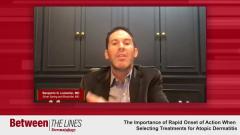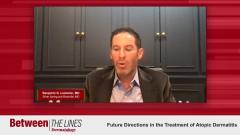
Dupilumab Efficacy: Long-term IGA and EASI Scores
Andrew F. Alexis, MD, MPH, and Benjamin N. Lockshin, MD, discuss the relevance of the 4-year efficacy data for dupilumab in adults with moderate to severe atopic dermatitis, with a focus on IGA and EASI scores.
Episodes in this series

Andrew F. Alexis, MD, MPH: What about this next cut from the data? This is moving from safety to efficacy. We’re here, we’re looking at the efficacy of dupilumab [by] looking at IGA [Investigator’s Global Assessment], at the proportion of patients who achieved an IGA score of 0 or 1 as well as the proportion of patients who achieved a reduction in IGA score of at least 2 points from baseline. Can you walk us through this data?
Benjamin N. Lockshin, MD: Absolutely. I think you mentioned from the get-go that the number of patients enrolled in the open-label extension from all these the earlier phase, I think [phase] 1, 2, and 3 studies, was just shy of 3000. [Regarding] the number of patients who made it to the first milestone, 52 weeks, what we see is that 74% of those patients actually had a reduction their [IGA] score of 2 or more points from the parent study baselines. We see that over 50% of those patients maintained or continued to achieve an [IGA] of 0 or 1. Remember, that encompasses patients who were on placebo or on dupilumab in those parent studies. I do want to acknowledge the fact that over time, there’s a potential for enrichment in this patient population. As patients who potentially aren’t doing well, are not tolerating the medication, drop out as time goes on, the number of patients in each of the time points does diminish. A critical eye will say, those numbers diminish tremendously as you get out to year 3 and 4. It should be recognized that many of the patients discontinued because this was now a commercially available product. This certainly happened in my patient population as well. Certain protocol changes did require transition into the commercially available product, resulting in lower numbers. But what this tells me in big, broad brushstrokes is that patients on either weekly or 2-week dosing, when you aggregate the 2, continue to do well over time [and have] that durability of response. As you mentioned earlier, talking about the marathon of the disease, this is what I talk about with patients. I tell patients at certain weigh points that you should have certain expectations. I tell patients, if you make it a year and you’re doing really well, the likelihood that you’re going to continue to do well for years to come is very good. Is there anything that you ascertain from this table, in addition to what I said?
Andrew F. Alexis, MD, MPH: Ben, I think you hit all the high points, and I’ll just emphasize your very good comment about the diminishing ends as we go on in time over the course of the study. To your point, the study was terminated by the sponsor because of regulatory approval and a commercialization of the drug, meaning the drug was available; therefore, about 810 patients were terminated by the study. If we look at how many patients were withdrawn from the study due to an adverse event, that number is quite low; only 114 subjects out of this large safety analysis set of over 2000 patients. That’s very reassuring.
TRANSCRIPT EDITED FOR CLARITY
Newsletter
Like what you’re reading? Subscribe to Dermatology Times for weekly updates on therapies, innovations, and real-world practice tips.



























